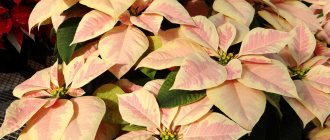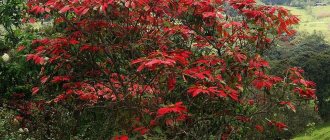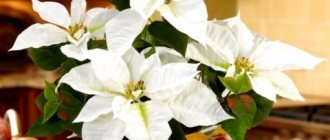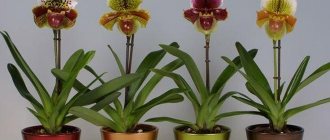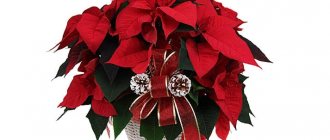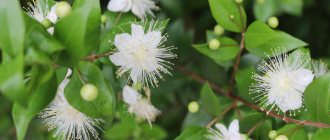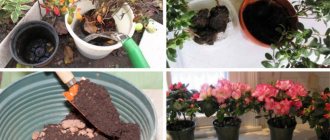Poinsettia (lat. Poinsettia), or beautiful spurge, is called by many gardeners the “Christmas star”. The evergreen shrub is native to Central America and the tropics of Mexico. In its native open spaces, the plant often has a height of 4 m, while on window sills its dimensions are quite modest - 30-50 cm.
Poinsettia appears on the shelves on the eve of the New Year holidays, so bouquet bushes with bright variegated leaves are considered a symbol of Christmas. Small yellowish milkweed flowers are framed by pink, red, and white bracts, sometimes mistaken for the flowers themselves.
Interesting! Among the Aztecs, the plant was considered a symbol of purity. Its juice was used to treat bodily ailments, used for tattooing, and dyed fabrics.
Another name for the bush, “Star of Bethlehem,” appeared thanks to biblical legends: bare branches were brought by poor children as a gift to the newborn Jesus. In the morning, red stars appeared on the branches. To this day, altars are decorated for Christmas with beautiful milkweed.
Features of cultivation
The charming Star of Bethlehem leaves no one indifferent - bright and colorful, it inspires, improves your emotional state, and lifts your spirits on long winter days.
For long flowering, very little is required - careful and proper maintenance :
- Lighting. Poinsettia actively develops in diffused but bright light. But he doesn’t like direct burning rays.
- Humidity and temperature. The flower needs warmth and regular spraying when flowering.
- Watering. The soil is kept moist, but stagnation of water in the pan is unacceptable. Likewise, a lack of moisture will cause leaf fall.
- The soil. The shrub grows well in slightly acidic soil, but also responds positively to neutral soil.
- Feeding. From the growing season until flowering, poinsettia should receive feeding twice a month. During flowering, not all gardeners feed it - this is at their discretion.
- Transfer. With annual replanting, a one-time flowering plant, as it is sold in stores, will become a perennial.
- Trimming. Sanitary and decorative pruning will greatly improve the condition and appearance of the bush.
It is important for the flower to provide optimal lighting and timely watering.
The annual cycle of the plant consists of 4 main periods , each of which requires certain care:
- Peace. The Christmas star rests after flowering for 2-2.5 months: end of winter - beginning of spring. Minimal care.
- Vegetation. In April, poinsettia wakes up and actively develops.
- Budding. Intensive growth stops, the plant forms buds. The period is the most crucial for the florist.
- Bloom. The brightest stage of flower development occurs during the New Year holidays. Care during this period is not difficult.
Propagation of poinsettia by cuttings
Most often, flower growers use the possibility of vegetative propagation. It is best that cuttings 10 to 15 cm long, obtained after trimming the poinsettia, take root at home in spring and early summer.
Since the plant secretes milky sap, which interferes not only with the drying of the cut, but also with root formation, before planting pieces of stems in the ground:
- their lower leaves are cut off;
- The cut sites are immersed in water for several minutes;
- then blot with a paper napkin;
- The tips of the stems are sprinkled with a root formation stimulator.
Now the cuttings intended for poinsettia propagation are ready for planting. As a substrate, you can use a light, breathable mixture of washed sand and perlite. The root system of young plants is not too large, so first and before transplanting the poinsettia to a permanent place of residence, you can use very small pots or cups with a capacity of up to 250 ml.
A drainage hole is made at the bottom of the container. The cuttings are immersed in the soil to a depth of 3 cm, this is enough. The seedlings are placed in an indoor greenhouse. Next, young poinsettias need:
- watering as needed;
- bright, but not direct light;
- constant temperature within 16–22 °C;
- regular ventilation.
This care is enough for the tops of the stems to sprout roots in 45–60 days and be ready to be transferred to permanent pots. To transplant poinsettias, take containers with a diameter of 7–10 cm, at the bottom of which a layer of drainage is made, and then filled with a substrate based on leaf and turf soil with the inclusion of a small amount of peat, cleared of foreign inclusions, and sand.
With the beginning of active growth, the top of the seedling is removed. This type of pruning of poinsettia at home allows you to immediately get a branching bush with several bright inflorescences.
Poinsettias that have already bloomed in the previous season are replanted in a similar manner. The procedure is carried out in the second half of spring after pruning the houseplant.
Problems when growing a flower
Poinsettia breeders sometimes encounter problems not related to diseases or pests:
- Yellowing of foliage. Frequently watering a flower, at the minimum permissible temperature, can cause rotting of the roots. The bush becomes sick and the leaves turn yellow, indicating a problem. The flowerpot is moved to a warmer room, sand is poured into the tray to help remove moisture. If the leaves are yellow for more than a week, then it is advisable to transplant the bush into a smaller flowerpot, removing the affected roots.
- Leaf fall. If abscission occurs at the end of flowering, the poinsettia is preparing for dormancy. Also, leaf shedding will be observed due to insufficient watering, with a sharp temperature change. You should inspect the bush more carefully and correct any shortcomings.
- Lack of flowering. Omission of agrotechnical recommendations postpones flowering for an indefinite period. It is necessary to reconsider the care, check the temperature and light intensity.
Appearance description
Wild poinsettias reach enormous sizes and bear little resemblance to the indoor, cultivated variety. Long bare stems, up to 4 meters in length, oval dark green leaves up to 10-15 cm, blooming with small flowers. The flowering period of wild milkweed is about 3 months, the plants themselves are perennials.
Indoor poiscentia differs from wild poisentia. Its height is about 20-30 cm, the bracts are about 15 cm. The colors can be different: pink, yellow, red and even bicolor. But it is the red poinsettia that is most often found.
Important: Poinsettia is a poisonous flower. It should be stored in a place where neither children nor animals will come into contact with it. After handling the flower, hands should be washed thoroughly.
Diseases and pests
Poinsettia rarely gets sick. All problems with her health arise due to non-compliance with agricultural practices. A deficiency of fertilizing, as well as excess or irregularity, temperature changes, poor-quality lighting, and unfair watering, turn into a blow for the plant:
- The stems droop, exposing the core;
- The leaf turns brown, turns yellow, falls off;
- The roots rot;
- The flower becomes covered with spots.
Poinsettia is most vulnerable to the following diseases :
- Gray rot, stem, root. The stems and inflorescences are covered with a gray coating, brown spots on the foliage. The flower is treated with Celandine, Skor, Fundazol.
- Powdery mildew. The white coating covering the bush gradually turns brown. Copper sulfate, Celandine, Skor, Topaz are used for treatment.
- Fusarium. The above-ground mass turns brown, then turns black. Withered greenery quickly dies. For processing you will need Fitosporin-M, Funlazol, Topaz.
Varieties
In the wild, poinsettia can reach a height of up to several meters. It is clear that such plants are not suitable for indoor conditions. Fortunately, flower growers have long paid attention to this species and are now using low-growing artificially bred varieties for home cultivation. Naturally, breeders not only reduced the height of the shrub itself. Since the 19th century, when the most beautiful poinsettia was first described by botanists, hundreds of its varieties have already been bred. This beautiful houseplant can now be found not only with “wild” red bracts, but also with pink, white, cream, orange, and variegated ones.
Among the most popular varieties:
- red and crimson – Premium Red, Angelica; Cortez Burgundy and Cortez Red, Galaxy, Emperor, Prestige Maroon, Sonora Fire;
- white - Snow White, Winter Rose White, Freedom White, Whitestar, Arctic White;
- pink - Cortez Pink, Polly Pink, Dolce Rose, Freedom Pink, Pink Yell;
- yellow - Lemon Snow.
In addition, the most beautiful poinsettia comes with bracts of mixed colors, with spots on them, contrasting edging, and veins. Some varieties look like organisms from another planet, rather than earthly plants.
Insect pests
Insects appear on hot days, especially when the plant lacks watering and moisture. Pests from other flowers can also move in. They are often caught with plants brought in from the street.
| Insect | Sign | Struggle | Prevention |
| Thrips | Black-brown parasites nest on the underside of the foliage, and it turns silvery-white and dries out. The stems are deformed. | Damage is removed, treated with decoctions of onions and marigolds. Dantop, Apache, Virom, Aktaru are used. | Maintain high humidity, place flypaper nearby. |
| Spider mite | The thin threads that weave around the petioles are difficult to notice, but the presence of the parasite is revealed by translucent spots on the foliage. | The soap-alcohol solution is applied for half an hour, then washed off with hot water (+40…+45). Treatment of the bush, soil and pot with Sunmite, Apollo, Actofit, Neoron. | Increase humidity, treat with infusions of garlic, onion, and tobacco. |
| Whitefly and aphids | The stems become thinner, the leaves become deformed and curled. | Admiral, Decis, Aktara, Fury. | New plants are kept in quarantine. Brought bouquets are kept away from indoor flowers. Treated weekly with decoctions of citrus skins, pine needles, and strong-smelling herbs. |
| Mealybug | The petioles, the bases of the shoots, and the undersides of the leaves are covered as if with dirty cotton wool. The greenery of the bush is sticky and deformed. Visible marks are removed with a soapy cotton swab. | The bush is treated with Fitoverm, Aktara, Aplaud. Watering and spraying with a decoction of horsetail, calendula, cyclamens. | Wiping and inspecting the bush. Maintaining optimal humidity, treating with infusion of onion or garlic. |
How to choose a poinsettia and what to do with it after purchasing?
All poinsettias look beautiful in stores. Do you want to choose a healthy flower from this variety? Then pay attention not only to the color of the flower and the shape of the leaves. Examine the entire plant carefully. The leaves should be evenly colored. There are no yellowing or stains on them, no defects - small holes, damage. When you bring your poinsettia home, carry out preventative treatment with some insecticidal preparation. Such products as “Fitoverm”, “Green Soap”, “Aktofit” are suitable. Spraying will prevent the appearance of pests and destroy them if they are present. Do not rush to immediately replant the flower in a new container, otherwise it may shed its leaves as a result of a sudden change in growing conditions. Let him get used to the new conditions. After 2 weeks you can start transplanting.
Video about the features of growing poinsettia
The author of the video explains how to make a plant bloom every year. Features of flower pruning - when and how it should be done. How to feed poinsettia for good growth and abundant flowering. Join the viewing!
If you approach the care of the Christmas star wisely, growing it will never be particularly difficult. Even a novice gardener will grow beautiful spurge if he has patience and treats the process responsibly. And on long winter evenings the flower will delight you with bright stars, giving comfort and joy.
Poinsettia: care at home. Briefly
Poinsettia at home is considered a rather troublesome plant, but if all care requirements are met, there will be no special problems when growing it. The main parameters of a favorable environment for a flower:
| Temperature | In summer and during the growing season, a temperature of 20-21 ºС is required, during the dormant period – no higher than 14 ºС. |
| Air humidity | High, maintained at a level of at least 80%. |
| Lighting | Bright, sunny, except for midday rays. |
| Watering | Frequently, more than 2 times a week, without allowing the soil to dry out. After flowering - once every 10 days. |
| Poinsettia soil | Nutritious, moisture-permeable with high-quality drainage. |
| Feeding and fertilizer | Mineral complexes for beautifully flowering plants throughout the entire period of active growth. |
| Poinsettia transplant | It is carried out annually at the end of the dormant period. |
| Reproduction | Apical cuttings. |
| Features of cultivation | The flower does not tolerate drafts and needs annual pruning. The sap of the plant, contrary to popular belief, is not poisonous, but can cause irritation in people prone to allergic skin reactions. |
Darkness
September is a very important period of preparation for flowering. The secret to its flowering is 14 hours of pitch darkness and 10 hours of intense light over 6-8 weeks. Every day in the evening, cover the plants with a bag that does not let in light or place them in a closet that you use least. During the period of bud formation, even the slightest illumination from a lantern in a window or a beam of light from the next room is harmful to the plant. At 10 hours of daylight, move the flower to the brightest place. The more light, the richer the color of the flowers. Watering should be reduced. When the first flowers appear, the plant can be switched to normal mode and artificial darkening can be stopped. In parallel with the formation of inflorescences, the stipules will be painted in their varietal color.
Humidity
Poinsettia loves moist air and this causes some problems for owners of very dry apartments. A representative of the tropics needs periodic spraying of the leaves. You can additionally humidify the air if near the pot:
- put wet rags or sponges;
- install water trays;
- install air humidifiers.
If you use spray bottles, the water in them should be slightly warm and settled. Cold drops can cause spots to form on the leaves, and hard tap water causes white deposits and streaks to appear on these indoor plants.
